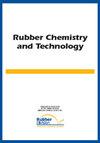飞机液压系统弹性体低温密封性能评价
IF 1.5
4区 工程技术
Q4 POLYMER SCIENCE
引用次数: 0
摘要
在135°C的空气或液压油中暴露最多28天后,通过一系列试验评估了飞机液压密封系统中使用的五种弹性体部件的低温密封性能。这些评估包括标准材料测试,如玻璃化转变温度(Tg)、10%收缩率下的温度回收率、机械测试、压缩设置以及测量特定温度下密封力的定制测试。此外,还进行了低温气体泄漏试验。丁腈橡胶在时效过程中随着伸长率的降低而变硬,由于交联密度的增加导致链迁移率降低,Tg增加,冷却和提取增塑剂时恢复力急剧下降。相比之下,氟碳橡胶(FKM)和环氧氯丙烷与丁腈橡胶(ECO)共混物的气体泄漏试验中,无论FKM或ECO是否老化,Tg值都具有较好的一致性,且密封温度(Tseal)最低。然而,丁腈橡胶老化后Tseal值明显高于Tg值,表明密封机理复杂。因此,仅依靠标准材料试验可能不足以准确预测飞机液压密封系统的低温密封性能。本文章由计算机程序翻译,如有差异,请以英文原文为准。
LOW TEMPERATURE SEALING BEHAVIOR EVALUATION OF ELASTOMERS IN AIRCRAFT HYDRAULIC SYSTEMS
ABSTRACT The low temperature sealing behaviors of five elastomer components used in aircraft hydraulic sealing systems were evaluated through a series of tests subsequent to exposure at 135 °C for a maximum of 28 days in air or hydraulic oil. These assessments encompassed standard material tests such as glass transition temperature (Tg), temperature retraction at 10% shrinkage, mechanical test, and compression set and a customized test to measure sealing force of a certain temperature. In addition, a low temperature gas leakage test was conducted. NBR stiffened upon aging with degradation of properties in an elongation loss, and Tg increased because chain mobility decreased due to increased crosslink density, and restoring force sharply decreased in cooling and in extracting plasticizer. In contrast, in the gas leakage test for both fluorocarbon rubber (FKM) and blends of epichlorohydrin with NBR (ECO), the Tg values showed good accordance, with minimal sealing temperature (Tseal), whether FKM or ECO were aged or not. However, the value of Tseal is significantly higher than that of Tg after NBR aging, indicating a complicated sealing mechanism. Thus, relying solely on standard material tests may not suffice for accurately forecasting the low temperature sealing performance in aircraft hydraulic sealing systems.
求助全文
通过发布文献求助,成功后即可免费获取论文全文。
去求助
来源期刊

Rubber Chemistry and Technology
工程技术-高分子科学
CiteScore
3.50
自引率
20.00%
发文量
21
审稿时长
3.6 months
期刊介绍:
The scope of RC&T covers:
-Chemistry and Properties-
Mechanics-
Materials Science-
Nanocomposites-
Biotechnology-
Rubber Recycling-
Green Technology-
Characterization and Simulation.
Published continuously since 1928, the journal provides the deepest archive of published research in the field. Rubber Chemistry & Technology is read by scientists and engineers in academia, industry and government.
 求助内容:
求助内容: 应助结果提醒方式:
应助结果提醒方式:


